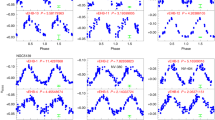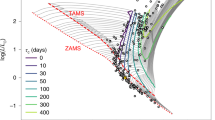Abstract
A knowledge of stellar ages is crucial for our understanding of many astrophysical phenomena, and yet ages can be difficult to determine. As they become older, stars lose mass and angular momentum, resulting in an observed slowdown in surface rotation1. The technique of ‘gyrochronology’ uses the rotation period of a star to calculate its age2,3. However, stars of known age must be used for calibration, and, until recently, the approach was untested for old stars (older than 1 gigayear, Gyr). Rotation periods are now known for stars in an open cluster of intermediate age4 (NGC 6819; 2.5 Gyr old), and for old field stars whose ages have been determined with asteroseismology5,6. The data for the cluster agree with previous period–age relations4, but these relations fail to describe the asteroseismic sample7. Here we report stellar evolutionary modelling5,6,8,9,10, and confirm the presence of unexpectedly rapid rotation in stars that are more evolved than the Sun. We demonstrate that models that incorporate dramatically weakened magnetic braking for old stars can—unlike existing models—reproduce both the asteroseismic and the cluster data. Our findings might suggest a fundamental change in the nature of ageing stellar dynamos, with the Sun being close to the critical transition to much weaker magnetized winds. This weakened braking limits the diagnostic power of gyrochronology for those stars that are more than halfway through their main-sequence lifetimes.
This is a preview of subscription content, access via your institution
Access options
Subscribe to this journal
Receive 51 print issues and online access
$199.00 per year
only $3.90 per issue
Buy this article
- Purchase on Springer Link
- Instant access to full article PDF
Prices may be subject to local taxes which are calculated during checkout



Similar content being viewed by others
Change history
13 January 2016
A citation was amended in the Abstract, and Extended Data Fig. 4 was corrected.
References
Skumanich, A. Time scales for CA II emission decay, rotational braking, and lithium depletion. Astrophys. J. 171, 565–567 (1972)
Barnes, S. A. A simple nonlinear model for the rotation of main-sequence cool stars. I. Introduction, implications for gyrochronology, and color-period diagrams. Astrophys. J. 722, 222–234 (2010)
Epstein, C. R. & Pinsonneault, M. H. How good a clock is rotation? The stellar rotation-mass-age relationship for old field stars. Astrophys. J. 780, 159–183 (2014)
Meibom, S. et al. A spin-down clock for cool stars from observations of the 2.5-billion-year-old cluster. Nature 517, 589–591 (2015)
García, R. A. Rotation and magnetism of Kepler pulsating solar-like stars. Towards asteroseismically calibrated age-rotation relations. Astron. Astrophys. 572, A34–A49 (2014)
Ceillier, T. et al. Rotation periods and seismic ages of KOIs—comparison with stars without detected planets from Kepler observations. Mon. Not. R. Astron. Soc. 456, 119–125 (2016)
Angus, R. & Aigrain, S., Foreman-Mackey, D. & McQuillan, A. Calibrating gyrochronology using Kepler asteroseismic targets. Mon. Not. R. Astron. Soc. 450, 1787–1798 (2015)
Mathur, S. et al. A uniform asteroseismic analysis of 22 solar-type stars observed by Kepler. Astrophys. J. 749, 152 (2012)
Metcalfe, T. S. et al. Properties of 42 solar-type Kepler targets from the asteroseismic modeling portal. Astrophys. J . 214 (Suppl.), 27–40 (2014)
Silva Aguirre, V. Ages and fundamental properties of Kepler exoplanet host stars from asteroseismology. Mon. Not. R. Astron. Soc. 452, 2127–2148 (2015)
Kawaler, S. D. Angular momentum loss in low-mass stars. Astrophys. J. 333, 236–247 (1988)
Durney, B. R. & Latour, J. On the angular momentum loss of late-type stars. Geophys. Astrophys. Fluid Dyn. 9, 241–255 (1977)
Noyes, R. W., Hartmann, L. W., Baliunas, S. L., Duncan, D. K. & Vaughan, A. H. Rotation, convection, and magnetic activity in lower main-sequence stars. Astrophys. J. 279, 763–777 (1984)
van Saders, J. L. & Pinsonneault, M. H. Fast star, slow Star; old Star, young Star: subgiant rotation as a population and stellar physics diagnostic. Astrophys. J. 776, 67–87 (2013)
Hartman, J. D. et al. Deep MMT transit survey of the open cluster M37. III. Stellar rotation at 550 Myr. Astrophys. J. 691, 342–364 (2009)
Metcalfe, T. S. et al. Asteroseismology of the solar analogs 16 Cyg A and B from Kepler observations. Astrophys. J. 748, L10–L16 (2012)
Aigrain, S. et al. Testing the recovery of stellar rotation signals from Kepler light curves using a blind hare-and-hounds exercise. Mon. Not. R. Astron. Soc. 450, 3211–3226 (2015)
Réville, V., Brun, A. S., Matt, S. P., Strugarek, A. & Pinto, R. F. The effect of magnetic topology on thermally driven wind: toward a general formulation of the braking law. Astrophys. J. 798, 116–131 (2015)
Garraffo, C., Drake, J. J. & Cohen, O. The dependence of stellar mass and angular momentum losses on latitude and on active region and dipolar magnetic fields. Astrophys. J. 807, L6 (2015)
Cohen, O., Drake, J. J., Kashyap, V. L. & Gombosi, T. I. The effect of magnetic spots on stellar winds and angular momentum loss. Astrophys. J. 699, 1501–1510 (2009)
Brown, T. The metastable dynamo model of stellar rotational evolution. Astrophys. J. 789, 101–113 (2014)
Morin, J., Dormy, E., Schrinner, M. & Donati, J.-F. Weak- and strong-field dynamos: from the Earth to the stars. Mon. Not. R. Astron. Soc. 418, L133–L137 (2011)
Davies, G. R. et al. Asteroseismic inference on rotation, gyrochronology and planetary dynamics of 16 Cygni. Mon. Not. R. Astron. Soc. 446, 2959–2966 (2015)
Davies, G. R. et al. Oscillation frequencies for 35 Kepler solar-type planet-hosting stars using Bayesian techniques and machine learning. Preprint at http://arXiv.org/abs/1511.02105 (2015)
Kovacs, G. et al. Stellar rotational periods in the planet hosting open cluster Praesepe. Mon. Not. R. Astron. Soc. 442, 2081–2093 (2014)
Meibom, S. et al. The Kepler cluster study: stellar rotation in NGC6811. Astrophys. J. 733, L9–L14 (2011)
Yontan, T. CCD UBVRI photometry of NGC 6811. Astrophys. Space Sci. 355, 267–281 (2015)
Jeffries, M. W. WOCS 40007: a detached eclipsing binary near the turnoff of the open cluster NGC 6819. Astron. J. 146, 58–78 (2013)
An, D. et al. The distances to open clusters from main-sequence fitting. III. Improved accuracy with empirically calibrated isochrones. Astron. J. 655, 233–260 (2007)
Chaplin, W. J. et al. Predicting the detectability of oscillations in solar-type stars observed by Kepler. Astrophys. J. 732, 54–62 (2011)
Holman, M. J. & Weigert, P. A. Long-term stability of planets in binary systems. Astron. J. 117, 621–628 (1999)
Acknowledgements
We wish to thank the Kavli Institute for Theoretical Physics and the organizers of the ‘Galactic Archaeology and Precision Stellar Astrophysics’ program held from January to April 2015. We thank B. Shappee for useful discussions. J.L.v.S. is a Carnegie-Princeton Fellow. T.S.M acknowledges the adopt-a-star crowdfunding program administered by White Dwarf Research Corp. G.R.D. acknowledges the support of the UK Science and Technology Facilities Council (STFC). M.H.P, T.S.M. and S.M. acknowledge support from NASA grant NNX15AF13G and National Science Foundation (NSF) grant AST-1411685. T.C. and R.A.G. received grants from the Centre National d’Études Spatiales (CNES) at the French Alternative Energies and Atomic Energy Commission (CEA). R.A.G. also acknowledges funding from the European Community Seventh Framework Programme (FP7/2007−2013) under grants 312844 (SPACEINN) and 269194 (IRSES/ASK). This research was supported in part by the NSF under grant NSF PHY11-25915. Funding for the Stellar Astrophysics Centre is provided by The Danish National Research Foundation (grant agreement DNRF106). This research is supported by the ASTERISK project (ASTERoseismic Investigations with SONG and Kepler) funded by the European Research Council (grant agreement 267864). V.S.A. acknowledges support from VILLUM FONDEN (research grant 10118).
Author information
Authors and Affiliations
Contributions
J.L.v.S. provided the physical interpretation of the rapid rotation and the rotational and stellar modelling. M.H.P. contributed to the design of the rotation tracer code, to ongoing YREC (Yale rotating stellar evolution code) development, and to interpretation of the results. T.S.M. carried out asteroseismic modelling portal (AMP) modelling of all targets. V.S.A. carried out Bayesian stellar algorithm (BASTA)–Garching stellar evolution code modelling. T.C., R.A.G. and S.M. developed and implemented the analysis of rotational modulation in Kepler data. G.R.D provided updated asteroseismic mode frequencies used in the modelling.
Corresponding authors
Ethics declarations
Competing interests
The authors declare no competing financial interests.
Extended data figures and tables
Extended Data Figure 1 The positions of all 21 Kepler stars on the Hertzsprung–Russell diagram.
We plot spectroscopic Teff (a proxy for mass) versus seismic log(g) (surface gravity), with 1σ observational error bars; the symbol size is proportional to the period ratio (AMP ages, fiducial models14). Colours and symbol conventions are as in Fig. 2. Evolutionary tracks are overplotted for [Z/H] = +0.3 (dotted lines) and [Z/H] = −0.1 (solid lines), for masses 0.8–1.3 M⊙ in increments of 0.1 M⊙. ([Z/H] = +0.3, M = 0.8 M⊙ is beyond the plotted area.)
Extended Data Figure 3 Period ratios using empirical gyrochronology relations.
Extended Data Figure 4 Detectability of stars in spot modulation.
Detection fractions for the 750 stars with noise in the hound-and-hare exercise of ref. 17, as a function of activity level A (where the activity level of the Sun is defined as A⊙ = 1) and rotation period. The total number of light curves searched for periodicity in each cell is overplotted. The dashed black line at P = 35 days represents the expected period for stars like the Sun under traditional gyrochronology relations found in the literature.
Extended Data Figure 5 Predicted versus observed rotation periods using ages determined with BASTA.
a, c, e, Plotted are the ratios of the periods predicted using the fiducial models14 to the observed rotation periods, as a function of stellar age. The grey band represents the offset expected from models in which Rocrit = 2.16. All error bars represent 1σ. b, d, f, Ratios of the predicted periods obtained from the empirical relation2 to the observed periods, plotted against stellar age. Stars are divided according to ZAMS Teff, using BASTA ZAMS Teff values: a, b, 5,900–6,200 K; c, d, 5,500–5,900 K; e, f, 5,100–5,400 K. All symbol conventions are as in Fig. 2.
Rights and permissions
About this article
Cite this article
van Saders, J., Ceillier, T., Metcalfe, T. et al. Weakened magnetic braking as the origin of anomalously rapid rotation in old field stars. Nature 529, 181–184 (2016). https://doi.org/10.1038/nature16168
Received:
Accepted:
Published:
Issue Date:
DOI: https://doi.org/10.1038/nature16168
This article is cited by
-
An abrupt change in the stellar spin-down law at the fully convective boundary
Nature Astronomy (2023)
-
On the behaviour of spin–orbit connection of exoplanets
Nature Astronomy (2023)
-
Simulations of Solar and Stellar Dynamos and Their Theoretical Interpretation
Space Science Reviews (2023)
-
Stellar Activity Cycles
Space Science Reviews (2023)
-
Scaling and Evolution of Stellar Magnetic Activity
Space Science Reviews (2023)
Comments
By submitting a comment you agree to abide by our Terms and Community Guidelines. If you find something abusive or that does not comply with our terms or guidelines please flag it as inappropriate.



